Mises, Ludwig von. Human Action: A Treatise on Economics
Подождите немного. Документ загружается.

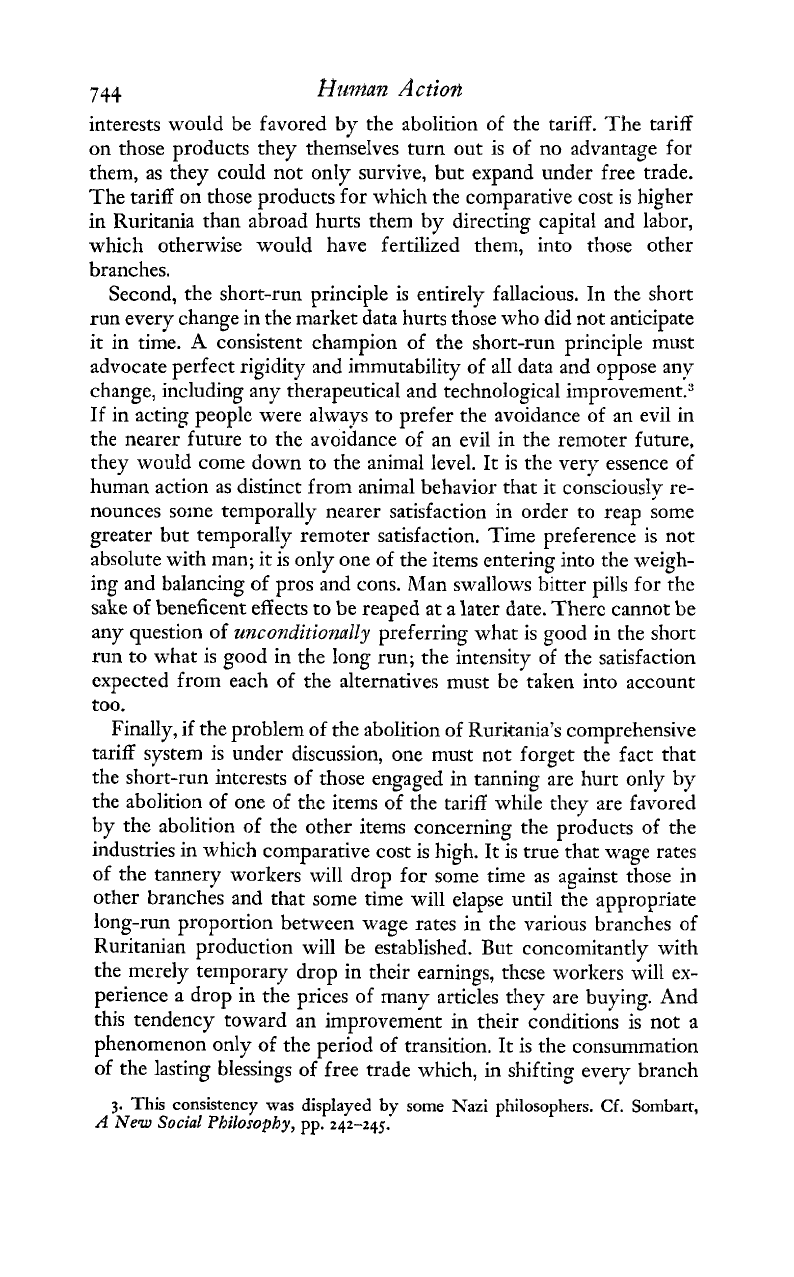
interests would be favored by the abolition of the tariff. The tariff
on those products they themselves turn out is of no advantage for
them, as they could not only survive, but expand under free trade.
The tariff on those products for which the comparative cost is higher
in Ruritania than abroad hurts them by directing capital and labor,
which otherwise would have fertilized them, into those other
branches.
Second, the short-run principle is entirely fallacious. In the short
run every change in the market data hurts those who did not anticipate
it in time.
A
consistent champion of the short-run principle must
advocate perfect rigidity and immutability of a11 data and oppose any
change, including any therapeutical and technological irnpr~vernent.~
If in acting people were always to prefer the avoidance of an evil in
the nearer future to the avoidance of an evil in the remoter future,
they would come down to the animal level.
It
is the very essence of
human action as distinct from animal behavior that it consciously re-
nounces some tcmporally nearer satisfaction in order to reap some
greater but ternporalIy remoter satisfaction. Time preference is not
absolute with man; it is only one of the items entering into the weigh-
ing and balancing of pros and cons. Adan swallows hitter pills for thc
sake
of
beneficent effects to be reaped at a later date. Therc cannot be
any question of
unconditionally
preferring what is good in the short
run to what is good in the long run; the intensity of the satisfaction
expected from each of the alternatives must be taken into account
too.
Finally, if the problem of the abolition of Ruritania's comprehensive
tariff system is under discussion, one must not forget the fact that
the short-run interests of those engaged in tanning are hurt only by
the abolition of one of the items of the tariff while thcy are favored
by the abolition of thc other items concerning the products of the
industries in which comparative cost is high. It is true that wage rates
of the tannery workers will drop for some time as against those in
other branches and that some time will elapse until the appropriate
long-run proportion between wage rates in the various branches of
Ruritanian production will be established. But concornitantly with
the merely temporary drop in their earnings, these workers will ex-
perience a drop in the prices of many articles they are buying. And
this tendency toward an improvement in their conditions is not a
phenomenon only of the period of transition. It is the consummation
of the lasting blessings of free trade which, in shifting every branch
3.
This
consistency was displayed
by
some hTazi philosophers.
Cf.
Sombart,
A
New
Socia!
Philosophy,
pp.
242-245.
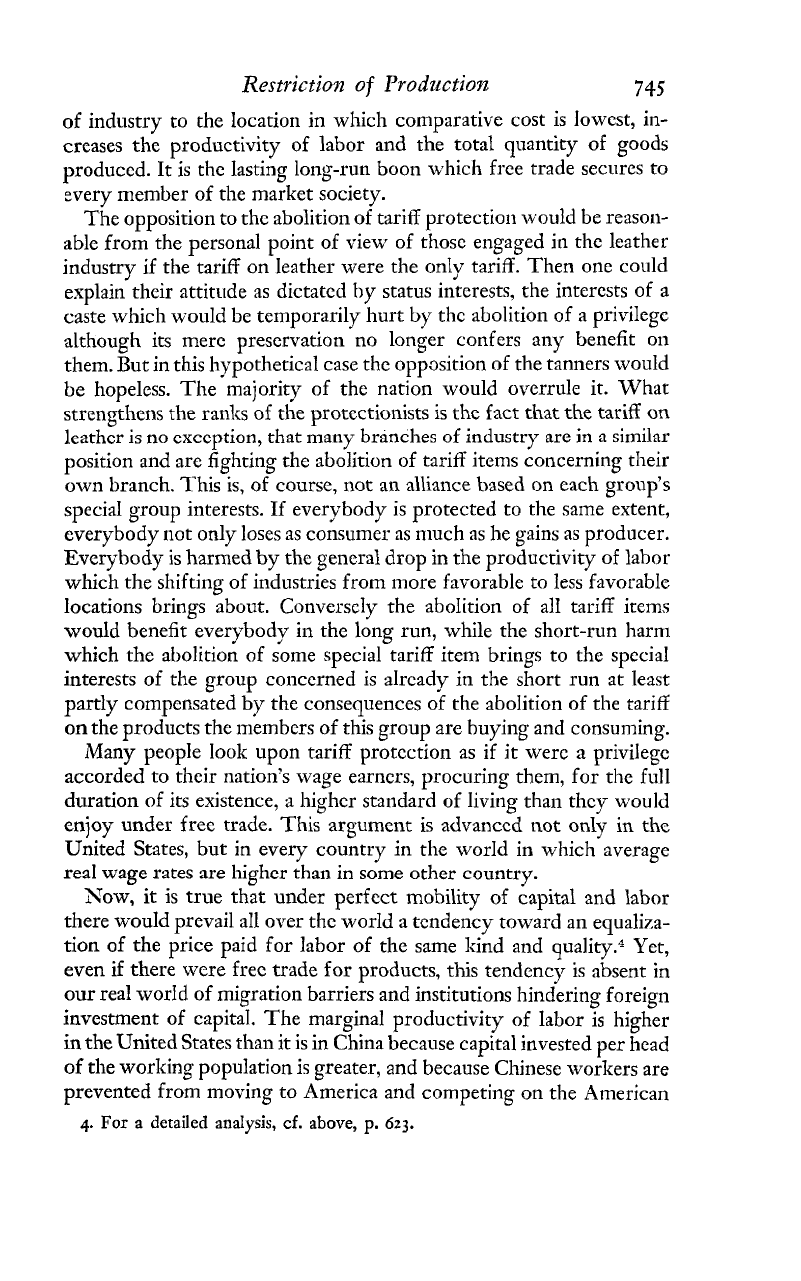
Restriction
of
Production
745
of industry to the location in which comparative cost is lowest, in-
creases the productivity of labor and the total quantity of goods
produced. It is the lasting long-run boon which free trade secures to
every member of the market society.
The opposition to the abolition of tariff protection would be reason-
able from the personal point of view of those engaged in the leather
industry if the tariff on leather were the onIy tariff. Then one could
explain their attitude as dictated
by
status interests, the interests of a
caste which would be temporarily hurt
by
the abolition of a privilege
although its mere preservation no longer confers any benefit on
them. But in this hypothetical case the opposition of the tanners would
be hopeless. The majority of the nation would overrule it. What
strengthens the ranks of the protectionists is the fact that the tariff on
leather is no exception, that many branches of industry are in a sirnilar
position and are fighting the abolition of tariff items concerning their
own branch. This is, of course, not an alliance based on each group's
special group interests. If everybody is protected to the same extent,
everybody not only loses as consumer as much as he gains as producer.
Everybody is harmed by the general drop in the productivity of labor
which the shifting of industries from more favorable to less favorable
locations brings about. Conversely the aboIition of all tariff items
would benefit everybody
in
the long run, while the short-run harm
which the abolition of some special tariff item brings to the special
interests of the group concerned is already in the short run at least
partly compensated by the consequences of the abolition of the tariff
on the products the members of this group are buying and consuming.
Many people look upon tariff protection as if it were a privilege
accorded to their nation's wage earners, procuring them, for the full
duration of its existence, a higher standard of living than they would
enjoy under free trade. This argument is advanced not only in thc
United States, but in every country in the world in which average
real wage rates are higher than
in
some other country.
Now, it is true that under perfect mobility of capital and labor
there would prevail all over the world a tendency toward an equaliza-
tion of the price paid for labor of the same kind and quality.* Yet,
even
if
there were free trade for products, this tendency is absent
in
our real worId of migration barriers and institutions hindering foreign
investment of capital. The marginal productivity of labor is higher
in the United States than it is in China because capital invested per head
of the working population is greater, and because Chinese workers are
prevented from moving to America and competing on the American
4.
For
a detailed
analysis,
cf.
above,
p.
623.
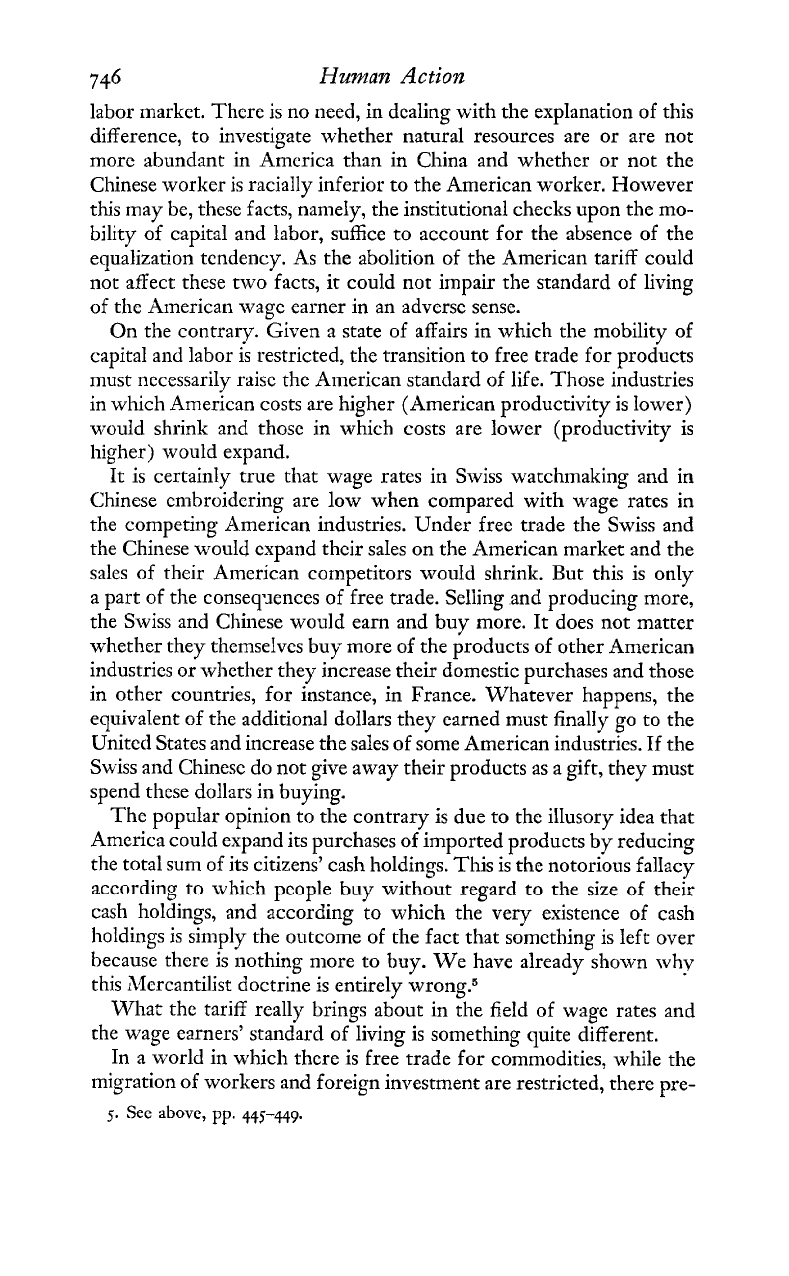
746
Human
Action
labor market. There is no need, in dealing with the explanation of this
difference, to investigate whether natural resources are or are not
more abundant in America than in China and whether or not the
Chinese worker is racially inferior to the American worker. However
this may be, these facts, namely, the institutional checks upon the mo-
bility of capital and labor, suffice to account for the absence of the
equalization tendency. As the abolition of the American tariff could
not affect these two facts, it could not impair the standard of living
of the A~nerican wage earner in an adverse sense.
On the contrary. Given a state of affairs in which the mobility of
capital and labor is restricted, the transition to free trade for products
must necessarily raisc the American standard of life. Those industries
in which American costs are higher (American productivity is lower)
would shrink and those in which costs are lower (productivity is
higher) would expand.
It is certainly true that wage rates in Swiss watchmaking and in
Chinese embroidering are low when compared with wage rates in
the competing American industries. Under free trade the Swiss and
the Chinese would expand their sales on the American market and the
sales of their American competitors would shrink. But this is only
a part
of
the conseqllences of free trade. Selling and producing more,
the Swiss and Chinese would earn and buy more. It does not matter
whether they themselves buy more of the products of other American
industries or whether they increase their domestic purchases and those
in other countries, for instance, in France. Whatever happens, the
equivaIent of the additional dollars they earned must finally go to the
United States and increase the sales of some American industries. If the
Swiss and Chinese do not give away their products as a gift, they must
spend these dollars in buying.
The popular opinion to the contrary is due to the illusory idea that
America could expand its purchases of imported products by reducing
the total sum of its citizens' cash holdings. This is the notorious fallacy
according to
whirh
pcnple
buy
withol~t
regd
to the
size
of
thcir
cash holdings, and according to which the very existence of cash
holdings is simply the outcome of the fact that something is left over
because there is nothing more to buy. We have already shown whv
this Mercantilist doctrine is entirely wrong.5
What the tariff really brings about in the field of wage rates and
the wage earners' standard of living is something quite different.
In a world in which there is free trade for commodities, while the
migration of workers and foreign investment are restricted, there pre-
5.
See
above,
pp.
445-449.
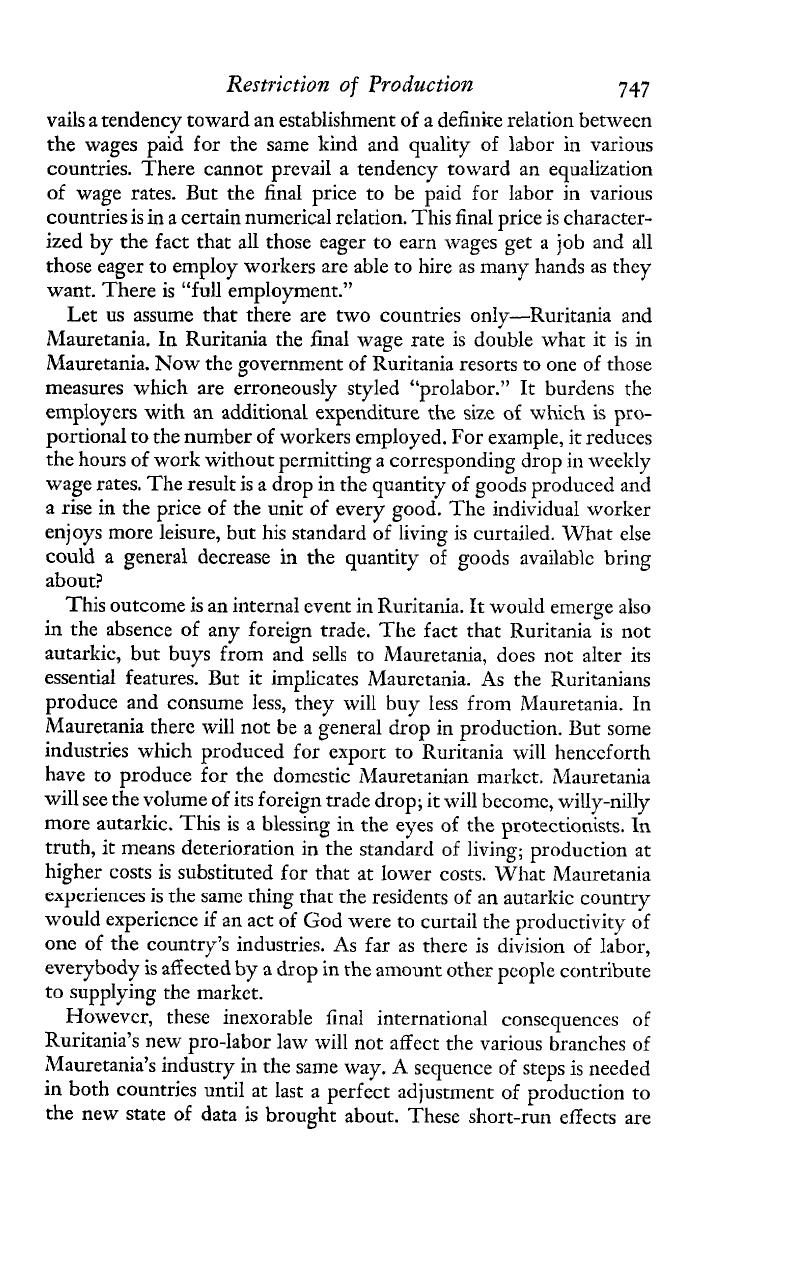
Restriction of Production
747
vails a tendency toward an establishment of a definite relation between
the wages
paid
for the same kind and quality of labor in various
countries. There cannot prevail a tendency toward an equalization
of wage rates. But the final price to be paid for labor in various
countries is in a certain numerical relation. This final price is character-
ized by the fact that all those eager to earn wages get a job and all
those eager to employ workers are able to hire as many hands as they
want. There is "full employment."
Let us assume that there are two countries only-Ruritania and
Mauretania. In Ruritania the final wage rate is double what it is in
Mauretania. Now the government of Ruritania resorts to one of those
measures which are erroneously styled "prolabor." It burdens the
employers with an additional expenditure
the
si7.e
of
which is
pro-
portional to the number of workers employed. For example, it reduces
the hours of work without ~ermitting a corresponding drop in weekly
wage rates. The result is a drop in the quantity of goods produced and
a rise in the price of the unit: of every good. The individuaI worker
enjoys more leisure, but his standard of living is curtailed. What else
could
a
general decrease in the quantity of goods availablc bring
about?
This outcome is an internal event in Ruritania. It would emerge also
in the absence of any foreign trade. The fact that Ruritania is not
autarkic, but buys from and sells to Mauretania, does not alter its
essential features. But it implicates Mauretania. As the Ruritanians
produce and consume less, they will buy less from Mauretania. In
Mauretania there will not be a general drop in production. But some
industries which produced for export to Ruritania will henceforth
have to produce for the domestic Mauretanian marltct. Mauretania
will see the volume of its foreign trade drop; it will become, willy-nilly
more autarkic. This is a blessing
in
the eyes of the protectionists.
In
truth, it means deterioration in the standard of living; production at
higher costs is substituted for that at lower costs. What Mauretania
experiences is the same thing that the residents of an autarkic country
would experience if an act of God were to curtail the productivity
of
onc of the country's industries. As far as there is division of labor,
everybody is affected
by
a drop in the amount other people contribute
to supplying the market.
However, these inexorable final international conscquences of
Ruritania's new pro-labor law will not affect the various branches of
Mauretania7s industry in the same way. A sequence of steps is needed
in both countries until at last a perfect adjustment of production to
the new state
of
data is brought about. These short-run effects are
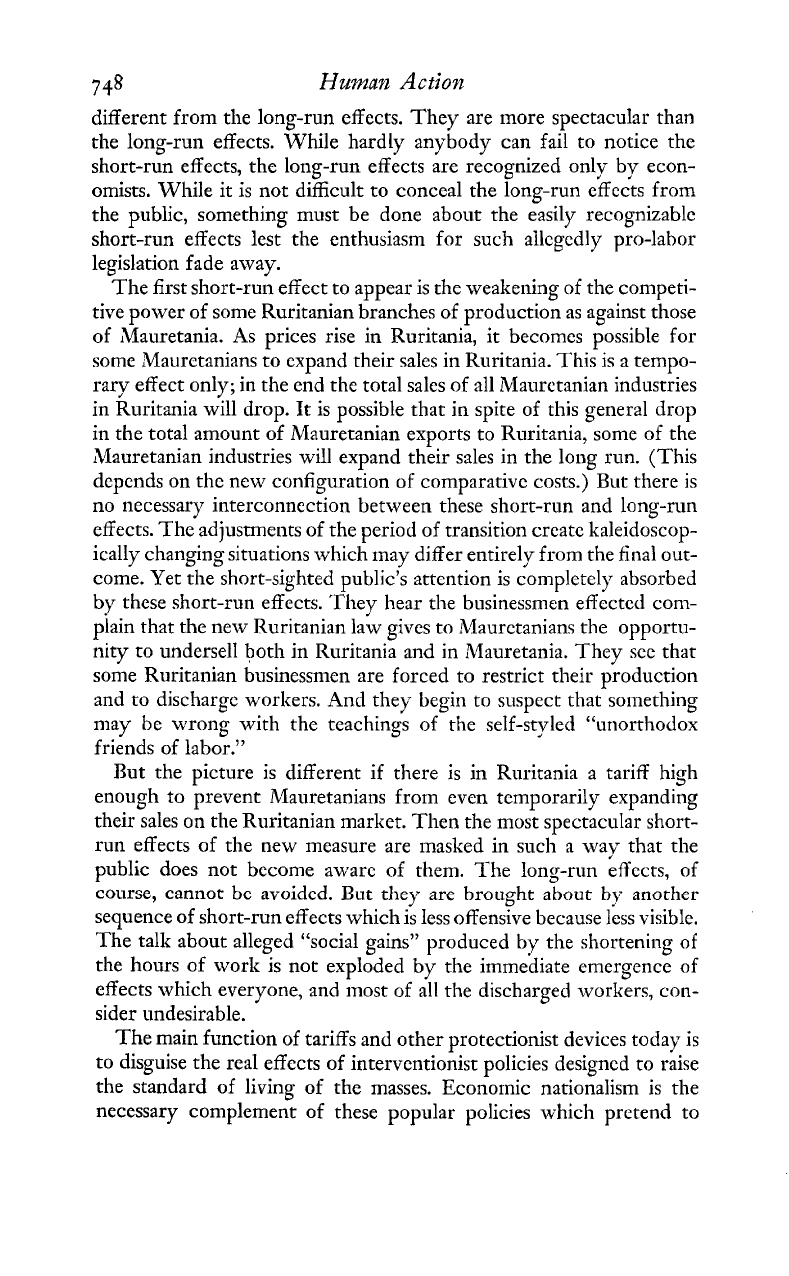
748
Human
Action
different from the long-run effects. They are more spectacular than
the long-run effects. While hardly anybody can fail to notice the
short-run effects, the long-run effects are recognized only by econ-
omists. While it is not difficult to conceal the long-run effects from
the public, something must be done about the easily recognizable
short-run effects lest the enthusiasm for such allcgcdly pro-labor
legislation fade away.
The first short-run effect to appear is the weakening of the competi-
tive power of some Ruritanian branches of production as against those
of Mauretania. As prices rise in Ruritania, it becomes possible for
some Maurctanians to cxpand their sales in Ruritania. This is a tempo-
rary effect only; in the end the total sales of all Mauretanian industries
in Ruritania will drop. It is possible that in spite of this general drop
in the total amount of Mauretanian exports to Ruritania, some of the
Mauretanian industries will expand their sales in the long run. (This
dcpcnds on the new configuration of comparative costs.) But there is
no necessary interconnection between these short-run and long-run
effects. The adjustments of the period of transition create kaleidoscop-
ically changing situations which may differ entirely from the final out-
come. Yet the short-sighted public's attcntion is cornpletcly absorbed
by these short-run effects. 'They hear the businessmen effcctcd corn-
piah that the new Ruritanian law gives to Mauretanians the opportu-
nity to undersell both in Ruritania and in Mauretania. They see that
some Ruritanian businessmen are forced to restrict their production
and to dischargc workers. And they begin to suspect that something
may be wrong with the teachings of the self-styled "unorthodox
friends of labor."
But the picture is different if there is in Ruritania a tariff high
enough to prevent Mauretanians from even temporarily expanding
their sales on the Ruritanian market. Then the most spectacular short-
run effects of the new measure are masked in such a way that the
public does not become aware of them. The long-run effects, of
nr\~xrca
nnnnnc
ha
n-7rx:,l-rl
R.,c CL,~
,,,
I.
,,..,
LC
,l.,.,c
L.,
,,,+l.,..
LVLIA~~,
LauuuL
UL
avuIuLu.
ULIL
LJIL
dlc
LJLULI~LIL
~LJIJUL
LJ)
alluLuc1
sequence of short-run effects which is less offensive because ~Ess visible.
The talk about alleged "social gains" produced
by
the shortening of
the hours of work is not exploded by the immehiate emergence of
effects which everyone, and most of all the discharged workers, con-
sider undesirable.
The main function of tariffs and other protectionist devices today is
to disguise the real effects of interventionist policies designcd to raise
the standard of living of the masses. Economic nationalism is the
necessary complement of these popular policies which pretend to
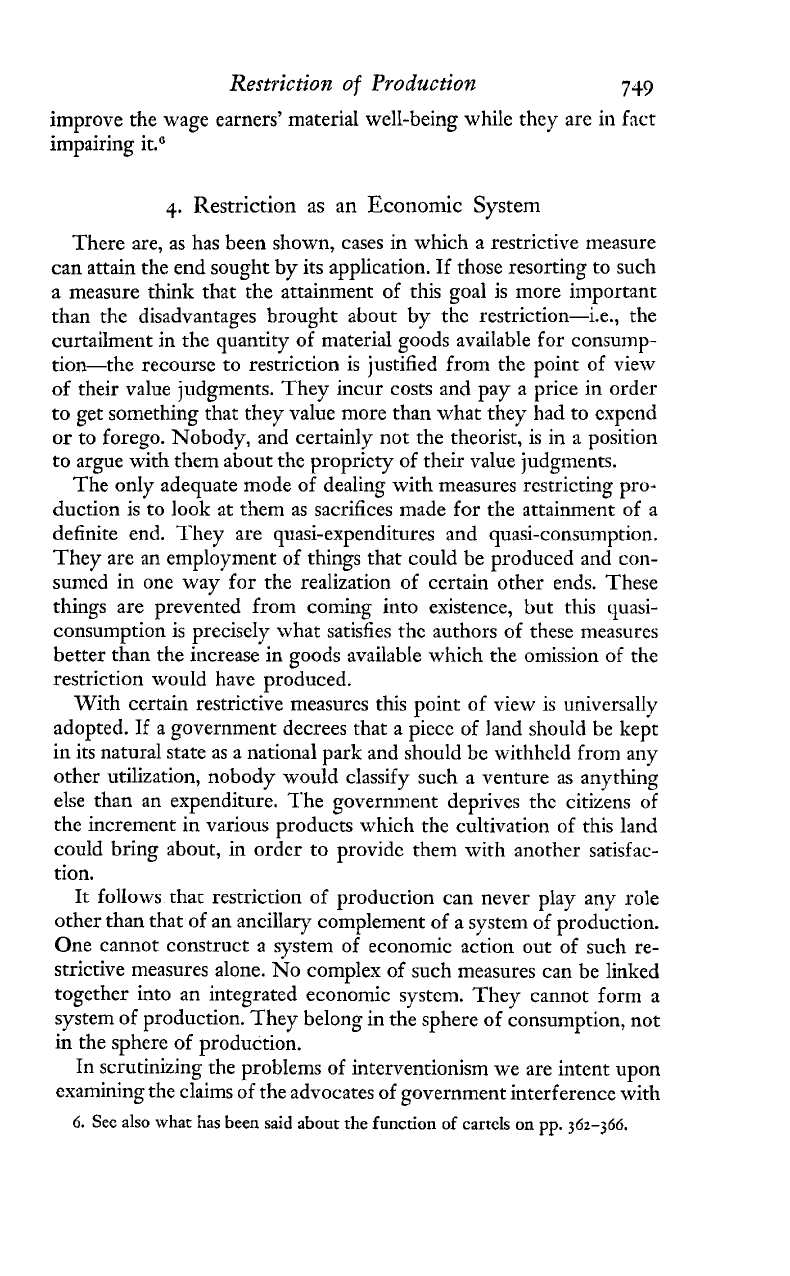
Restriction
of
Productio~z
749
improve the wage earners' material well-being while they are in fact
impairing itnG
4.
Restriction as an Econon~ic System
There are, as has been shown, cases in which a restrictive measure
can attain the end sought by its application. If those resorting to such
a measure think that the attainment of this goal
is
more important
than the disadvantages brought about by the restriction-i.e., the
curtailment in the quantity of material goods available for consump-
tion-the recourse to restriction is justified from the point of view
of their value judgments. They incur costs and pay a price in ordcr
to get something that they value more than what they had to expend
or to forego. Nobody, and certainly not the theorist, is in a position
to argue with them about the propriety of their value judgments.
The only adequate mode of dealing with measures restricting pro.
duction is to look at them as sacrifices made for the attainment of a
definite end. They are quasi-expenditures and quasi-consumption.
They are an employment of things that could be produced and con-
sumed in one way for the realization of certain other ends. These
things are prevented from coming into existence,
but
this quasi-
consumption is precisely what satisfies the authors of these measures
better than the increase in goods available which the omission of the
restriction would have produced.
With certain restrictive measures this point of view is universally
adopted. If a government decrees that a piece of land should be kept
in its natural state as a national park and should be withheld from any
other utilization, nobody would classify such a venture as anything
else than an expenditure. The government deprives the citizens
of
the increment in various products which the cultivation of this land
could bring about, in ordcr to provide them with another satisfac-
tion.
it
ioiiows hat restricrion of production can never piay any roie
other than that of an ancillary complement of a system of production.
One cannot construct a system of economic action out of such re-
strictive measures alone. No complex of such measures can be linked
together into an integrated economic system. They cannot form a
system of production. They belong in the sphere of consumption, not
in the sphere of production.
In scrutinizing the problems of interventionism w-e are intent upon
examining the claims of the advocates of government interference with
6.
See also what has been said about
the
function of cartels
on
pp.
362-366.
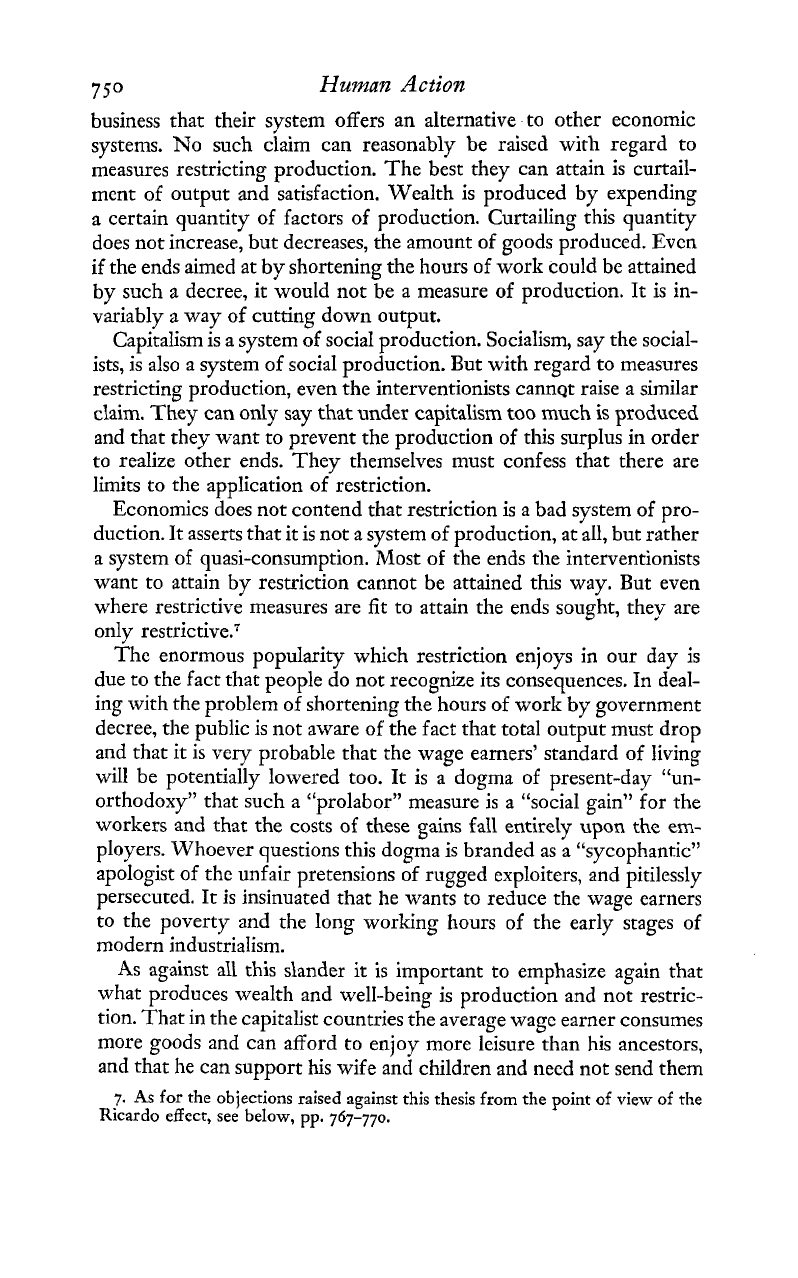
7
So
Human
Action
business that their system offers an alternative to other economic
systems. No such claim can reasonably be raised with regard to
measures restricting production. The best they can attain is curtail-
ment of output and satisfaction. Wealth is produced by expending
a certain quantity of factors of production. Curtailing this quantity
does not increase, but decreases, the amount of goods produced. Even
if the ends aimed at by shortening the hours of work could be attained
by such a decree, it would not be a measure of production. It is in-
variably a way of cutting down output.
Capitalism is a system of social production. Socialism, say the social-
ists, is also a system of social production. But with regard to measures
restricting production, even the interventionists cannQt raise a similar
claim. They can only say that under capitalism too much
is
produced
and that they want to prevent the production of this surplus in order
to realize other ends. They themselves must confess that there are
limits to the application of restriction.
Economics does not contend that restriction is a bad system of pro-
duction. It asserts that it is not a system of production, at all, but rather
a system of quasi-consumption, Most of the ends the interventionists
want to attain by restriction cannot be attained this way. But even
where restrictive measures are
fit
to attain the ends sought, they are
only restrictive.?
The enormous popularity which restriction enjoys in our day
is
due to the fact that people do not recognize its consequences. In deal-
ing with the problem of shortening the hours of work by government
decree, the public is not aware of the fact that total output must drop
and that it is very probable that the wage earners' standard of living
will be potentially lowered too. It is a dogma of present-day "un-
orthodoxy" that such a "prolabor" measure is a "social gain" for the
workers and that the costs of these gains fall entirely upon the
em-
ployers. Whoever questions this dogma is branded as a "sycophantic"
apologist of the unfair pretensions of rugged exploiters, and pitilessly
persecuted. It is insinuated that he wants to reduce the wage earners
to the poverty and the long working hours of the early stages of
modern industrialism.
As against all this slander it is important to emphasize again that
what produces wealth and well-being is production and not restric-
tion. That in the capitalist countries the average wage earner consumes
more goods and can afford to enjoy more leisure than his ancestors,
and that he can support his wife and children and need not send them
7.
As for the objections raised against this thesis from the point of view of the
Ricardo effect, see beIow,
pp.
767-770.
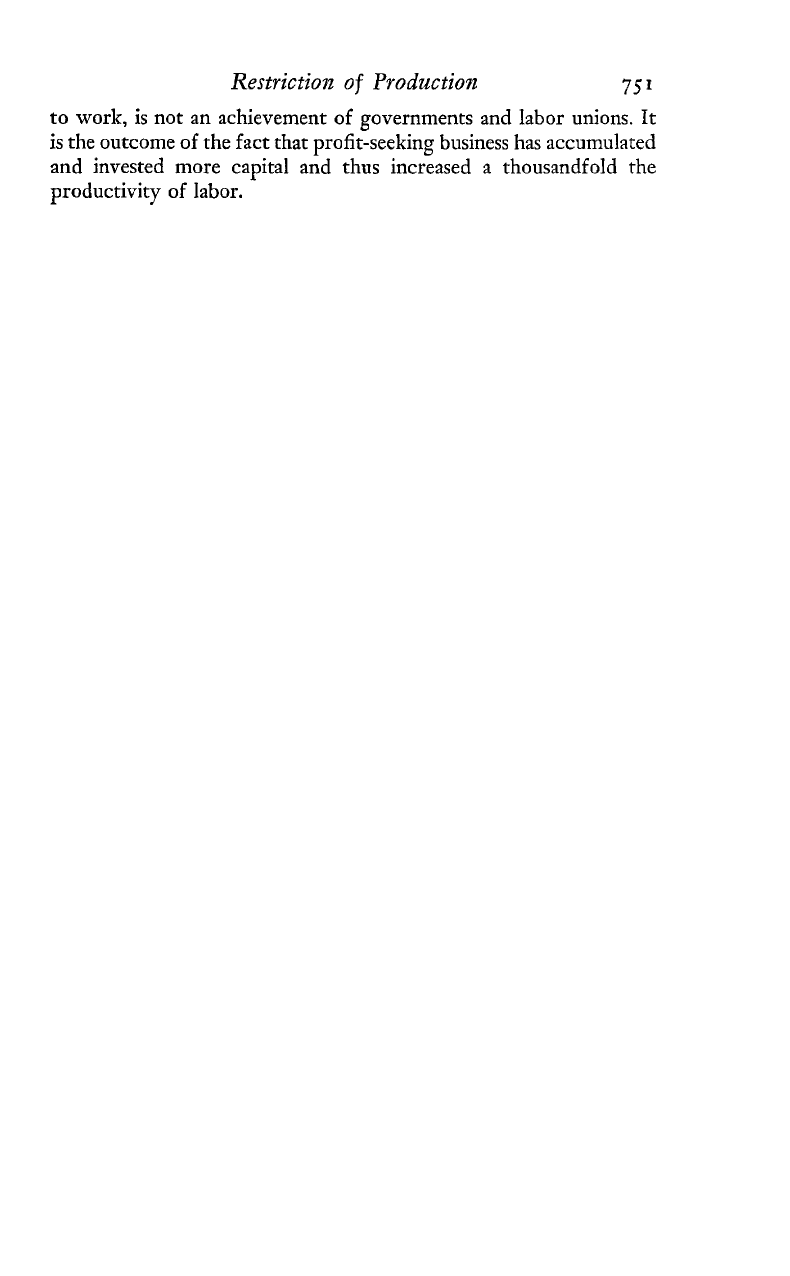
Restriction of Production
751
to work, is not an achievement of governments and labor unions. It
is
the outcome of the fact that profit-seeking business has accumulated
and invested more capital and thus increased a thousandfold the
productivity of labor.
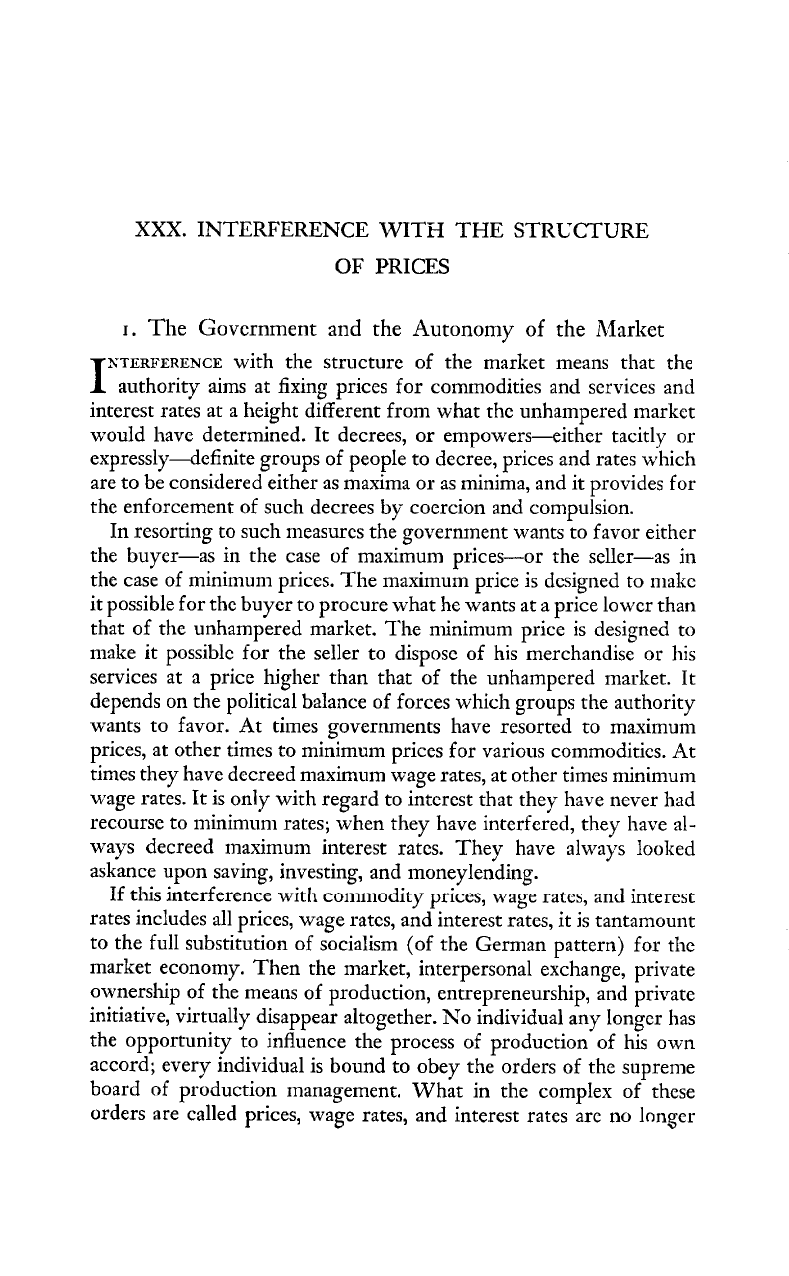
XXX.
INTERFERENCE WITH THE STRTJCTURE
OF
PRICES
I.
The Govcrnrnent and the Autonomy of the Market
~RFERENCE
with the structure of the market means that the
authority aims at fixing prices for commodities and services and
I"'"
interest rates at a height different from what the unhampered ~narket
would have determined. It decrees, or empowers--either tacitly or
expressly--definite groups of people to decree, prices and rates which
are to be considered either as maxima or as minima, and it provides for
the enforcement of such decrees by coercion and compulsion.
In resorting to such measurcs the government wants to favor either
the buyer-as in the case of maximum prices-or the seller-as in
the case of minimum prices. The maximum price is designed to niakc
it possible for the buyer to procure what he wants at a price lower than
that
of
the unhampered market. The minimum price is designed to
make it possiblc for the seller to disposc of his merchandise or his
services at a price higher than that of the unhampered market. It
depends on the political balance of forces which groups the authority
wants to favor. At times governments have resorted to maximum
prices, at other times to minimum prices for various commodities. At
times they have decreed maximum wage rates, at other times minimum
wage rates. It is only with regard to intcrcst that they have nevcr
had
recourse to minimum rates; when they have interfered, they have al-
ways decreed maximum interest rates. They have always looked
askance upon saving, investing, and moneylending.
11
*I-:-
:-&-A
----
--
--
:&
LL
ula
ILILCLLCICIILC
wlih
cummodity pices, wage rates,
and
interest
rates includes all prices, wage rates, and interest rates, it is tantamount
to the fulI substitution of socialism (of the German pattern) for the
market economy. Then the market, interpersonal exchange, private
ownership of the means of production, entrepreneurship, and private
initiative, virtually disappear altogether. No individual any longer has
the opportunity to influence the process of production of his own
accord; every individual is bound to obey the orders of the supreme
board of production management. What in the complex of these
orders are called prices, wage rates, and interest rates are no longer
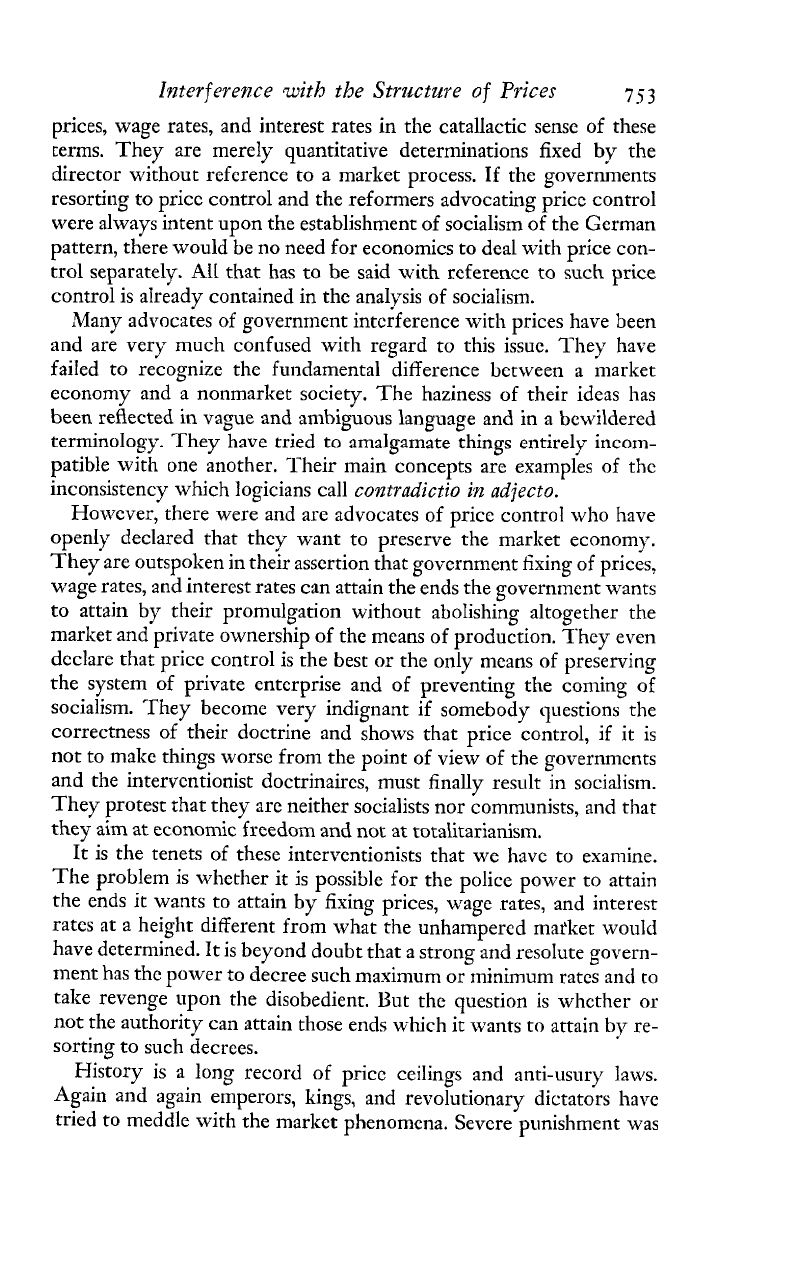
Interference
with
the Strncture of Prices
753
prices, wage rates, and interest rates in the catallactic sense of these
terms. They are merely quantitative determinations fixed by the
director without reference to
a
market process. If the governments
resorting to pricc control and the reformers advocating pricc control
were always intent upon the establishment of socialism of the German
pattern, there would be no need for economics to deal with
rice
con-
trol separately.
All
that has to be said with reference to such price
control is already contained in the analysis of sociaIism.
Many advocates of government interference with prices have been
and are very much confused with regard to this issue. They have
failed to recognize the fundamental difference between a market
economy and a nonmarket society. The haziness of their ideas has
been reflected in vague and ambiguous language and in a bewildered
terminology. They have tried to amalgamate things entirely incorn-
patible with one another. Their main concepts arc examples of the
inconsistency which logicians call
contradictio
in
adjecto.
However, there were and are advocates of price control who have
openly declared that they want to preserve the market economy.
They are outspoken in their assertion that govcrnment fixing of prices,
wage rates, and intercst rates can attain the ends the govcrnment wants
to attain by their promulgation without abolishing altogether the
market and private ownership of the means of production. They even
declare that price control is the best or the only means of preserving
the system of private enterprise and of preventing the coming of
socialism. They become very indignant if somebody questions the
correctness of their doctrine and shows that price control, if it is
not to make things worse from the point of view of the governments
and the intervcntionist doctrinaires, must finally result in socialism.
They protest that they are neither socialists nor communists, and that
they
aim
at economic freedom and not at totalitarianism.
It is the tenets of these iilterventionists that we havc to examine.
The problem is whcther it
is
possible for the police power to attain
the ends it wants to attain by fixing prices, wage rates, and interest
rates at
a
height different from what the unhampered matket would
have determined. It is beyond doubt that a strong and resolute govern-
ment has the power to decree such maximum or ~ninimum rates and to
take revenge upon the disobedient. But the question is whcther or
not the authority can attain those ends which it wants to attain by re-
sorting to such decrees.
History is a long record of price ceilings and anti-usury laws.
Again and again emperors, kings, and revolutionary dictators have
tried to meddle with the market phenomena. Severe punishment was
